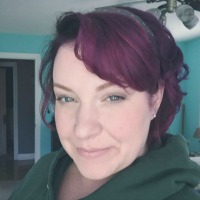Healing stories inspire and motivate us to reclaim our health by healing. This guest post is a heart-wrenching story of what it’s like to be abused as a child and how Heather chose to become an adult survivor. She is the Founder of The Phoenix Gathering, an online resource for adult survivors of child abuse.
I have been actively working on my healing journey since 1993.
I first remembered that I was sexually abused around the age of 3 by two family members in a ritualistic form. The realization happened the night before I left for college, my freshman year. I don’t recall the events in their entirety; I see them in flash bits where I can put them together to know enough of what happened.
I was emotionally and physically abused by my biological mother since birth. These patterns continued until I broke contact with her almost 15 years ago. She was a blend of Paranoid Schizophrenic with a heaping spoonful of Bi-Polar mixed in, all previously diagnosed and untreated.
She used to hit or kick me when she would hear awful things in her head, which always took on my voice. The youngest I can remember this happening was when I was watching cartoons. I believe I was four. One minute I was enjoying a particularly entertaining episode of Scooby Doo, and suddenly I was being slapped extremely hard on the back of my head, then violently grabbed and slapped across the face. The physical violence was a major part of my daily reality as a child.
She also decided that kidnapping me at the age of 3 was a good idea. I was born in Sacramento, CA, and she brought me to Michigan. During the 70’s, we didn’t have Amber Alerts or laws in place for kidnapping, so she got away with it. My father was told there was nothing he could do. He could spend the money and try to fight her in court, but he would lose. Back then, the firm belief was that the child belongs to the mother.
As I grew older, my existence evolved into trying to figure out different ways I could avoid her. How to remain as invisible as possible, how to fend off her physical assaults, and keeping myself from being hurt emotionally, mentally, and physically.
I attempted suicide when I was 15. Thankfully, I was unsuccessful. This was my first wake-up call that it wasn’t me, it was her. From that point on, I took every psychology class that was available in my high school, read books, and started on my real path of education. I realized the truth, which was that she was broken and truly couldn’t understand what she was doing. She was a victim in a long line of extreme family abuse, and she knew nothing else.
Child Abuse – My Healing Journey
My desire to learn more catapulted me to where I am today. I am a firm believer in education and naming the abuse and the abuser. Identifying what was done to us, giving it a name, and calling the abuser for what they are–Physical Abuser, Emotional Abuser, Sexual Abuser. When we give it a name, we start to take our power back.
There are three things that I have found that encourage real success in healing as an Adult Survivor:

1. Tell Your Story
Every time you tell your story, you are releasing more of the pain and trauma. Finding a therapist that you feel comfortable with is the first step.
You will eventually come to the place where you can share your story without the tears, the physical reactions of fight or flight like the tremors, twitches, etc. and the anger. It transitions from “what is” to a place of “what was.” It doesn’t define you anymore; you define it.
Eventually, you may able to tell your story publicly, which could help other Adult survivors who aren’t able to share their stories yet. You will be showing them that they aren’t alone, which is very powerful indeed.

2. Find Support
Isolation, secrecy, and confinement are some of the issues that survivors deal with when trying to work on healing. They often find that their loved ones either don’t believe them, don’t know how to respond, or how to give them the love and support that they need.
They begin to feel rejected and alone, which can result in attempts to shove the past down into Pandora’s Box again. The truth is that this will never work. Triggers and negative self-sabotage will always be there to remind us of what happened.
If you are a survivor who doesn’t have support from loved ones, friends, or family, the next place is to locate a support group in your area, or online.

3. Educate Yourself
Read books, take psychology classes, watch documentaries. Absorb as much as you can to educate yourself. Again, by identifying the facts of what has happened to you, and the common psychological and behavioral patterns of abusers you are taking your power back.
Also, be open to all forms of emotional and trauma healing. There is no one set way to getting better. What works for one person may not work for another.
Alternative Healing Methods
EMDR (Eye Movement Desensitization and Reprocessing)
EMDR doesn’t rely on talk therapy or medications. Instead, EMDR uses a patient’s rapid, rhythmic eye movements. These eye movements dampen the power of emotionally charged memories of past traumatic events. Treatment sessions can last up to 90 minutes and may require 2-3 sessions.
Your therapist will move his or her fingers back and forth in front of your face or use an LED light bar. You follow these motions with your eyes while the EMDR therapist walks you through recalling a disturbing event. This will include the emotions and body sensations that go along with it. The therapist may also have you wear an ear bud that plays a certain tone, and a clip on “thumper” that pulses a rhythmic beat on one of your fingers.
Then, the therapist will either guide you towards empowering yourself by re-framing the traumatic event into a better outcome, or they will gradually guide you to shift your thoughts to more pleasant ones. Some therapists use alternatives to finger movements, such as hand or toe tapping or musical tones.
This therapy is often described as “Night and Day” results for Survivors and provides a profound sense of freedom.
Tapping
There are two forms of tapping. One is more widely recognized as EFT, which stands for “Emotional Freedom Technique,” and the other less commonly known type is TFT, which means “Thought Field Therapy.”
Both practices focus on pressure points found in the Meridian system of the human body, which are the same points used in Acupuncture. These certain points on the body are tapped, while the person is focused on the emotional feelings and/or thoughts of a particular trauma or issue. The main difference between EFT and TFT is the process itself.
EFT generally uses all the major tapping points, done simultaneously with verbal affirming and releasing statements. The process can take anywhere from 15-30 minutes, depending on how severely rooted the issue is, with a result of releasing the emotional trauma or issue.
TFT uses specifically designed tapping point algorithms, targeted towards the issue and/or trauma. The client focuses their mind on the issue, follows the specific tapping series as instructed by their therapist or practitioner, and within 10-15 minutes, they can effectively “shut it off” like a light switch.
Both of these fall under what is known as “Energy Psychology” and have been found to be very beneficial in healing emotional wounds and traumas, fears, stress, and anxiety in survivors.
I have personally used EMDR and TFT in my own healing journey, and they have been powerful tools. I was able to free myself from the deeply rooted fears, anxiety, stress, sadness, anger, and shame from the years of my childhood abuse.
This enabled me to begin writing the story of my life in my own words and beliefs, versus the damaged ones that existed previously.
I’d like to close with “I Pledge Allegiance to Myself” by my favorite Author and speaker, Scott Stabile, as this piece has always given me strength and inspiration. May it bring the same for you.
He says, “If you make one commitment, let it be to love yourself as completely as possible. No exceptions. No conditions. No restraint.”

I Pledge Allegiance to Myself
“I commit to loving myself with everything I’ve got, even when I’m inclined not to, even when my mind directs me otherwise, even when others treat me poorly, even when I’m exhausted and overwhelmed and feel like I have nothing more to give. Even then, I will give my love to myself, because I am important and worthy and divine. I will love myself wholly and wildly and without inhibition because I understand that by doing so I open my entire world to choices and connections and realities rooted in this love I give to myself. By loving myself, I invite love into every aspect of my life, as well as the lives of everyone I encounter. I commit to loving myself because I am a being of love and function at my beautiful best when I live in and from and with this astounding wealth of love I have to share. For these reasons, and for every other life-affirming reason that exists in this world, I hereby commit to loving myself with absolutely everything I’ve got.”
You are worth this pledge to yourself. It will change everything.

Heather Durling is the Founder of The Phoenix Gathering, an online resource for adult survivors of child abuse. She is a fellow survivor who strives to learn new ways of thriving while sharing her knowledge and experiences with those on their own healing journey. Her purpose is to help fellow survivors of trauma and abuse, both childhood and present, get to a place of thriving while seeing their own amazing strengths and abilities. She is also a co-facilitator for a local support group, speaker, writer, and a closet herbal mad scientist.
Connect with Heather: Facebook | Twitter
Thank you to Pexels.com for their stock photography.

